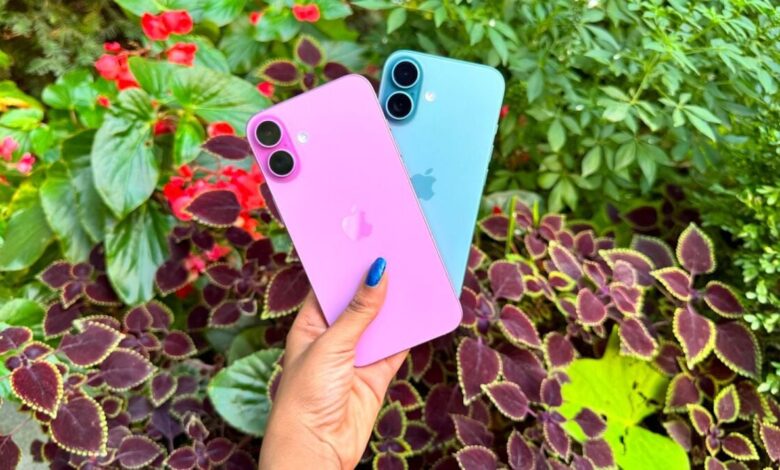iPhone 16 and 16 Plus review: So sweet, you’ll go ‘cheap’

A Mashable Choice Award is a badge of honor, reserved for the absolute best stuff we’ve tested and loved.
Table of Contents
The iPhone 16 and iPhone 16 Plus were never on my radar — until I had a sudden change of heart.
As a Pro Max exclusivist, the entry-level iPhone typically doesn’t catch my eye. After all, “Who wants a puny little phone?” I once thought.
And the “Plus” was always the awkward middle child, often ignored for the base model or the top-tier variant.
However, my experience with these phones has changed my mind. For those who don’t need pro-level photo and video capture, I’d go as far as saying that the iPhone 16 Plus is a better buy than the iPhone 16 Pro (though not the iPhone 16 Pro Max).
Stick around for everything that made me reconsider the iPhone 16 and iPhone 16 Plus models as viable daily drivers.
iPhone 16 and iPhone 16 Plus price and specs
Before I can dive into the meat and potatoes of this review, I need to give you some insight into how much you’ll have to spend on the iPhone 16 and iPhone 16 Plus.

iPhone 16
Credit: Kimberly Gedeon / Mashable
The iPhone 16, available for pre-order as of now, starts at $799 via Apple’s official store. The iPhone 16 Plus, on the other hand, starts at $899.
“Why does the iPhone 16 Plus cost more than the iPhone 16?” you may be wondering. Well, the iPhone 16 Plus has a larger display and a bigger battery, which means you should be able to squeeze out more runtime on a single charge (more on that later).
Other than the aforementioned differences, the iPhone 16 and iPhone 16 Plus both share the same specs, including the following:
-
New A18 chip
-
8GB of RAM (required for Apple Intelligence support)
-
New Camera Control button
-
Action Button from last year’s iPhone 15 Pro models
-
128GB, 256GB, and 512GB storage options
I highly recommend getting the 256GB storage option. Take it from me, 128GB runs out pretty quickly — in about a year and a half, give or take. (But I also understand there are budget constraints, so iCloud+ is another option for storage space if you don’t mind subscriptions.)
iPhone 16 and iPhone 16 Plus design
The iPhone 16 Plus review unit I received, draped in bubble-gum pink deliciousness, would have been a showstopper during 2023’s peak Barbie craze. It’s just dripping in Margot Robbie cuteness, cotton candy sweetness, and pink lemonade joy.

iPhone 16 Plus in Pink
Credit: Kimberly Gedeon / Mashable
Simply called “Pink,” this rose-tinted shade is available only for iPhone 16 and iPhone 16 Plus.
If you decide to go caseless (because you love this color as much as I do), you’ll be relieved to know that iPhone 16 lineup is now equipped with an even more durable display glass that’s technically “Ceramic Shield 2.” The OG Ceramic Shield debuted with the iPhone 12, and four generations later, we’ve got a new-gen Ceramic Shield that is 50% tougher, according to Apple.
In other words, the screen on the iPhone 16 should be just a little more resistant to your clumsy incidents — within reason, of course. (Don’t get too clumsy.)
My non-Plus iPhone 16, however, comes in teal. Not my taste (I would have preferred Ultramarine), but I love Apple’s decision to leave the pastel palettes behind, going deep, vivid, and rich. Other colors on the iPhone 16 menu include black and white.

Credit: Kimberly Gedeon / Mashable
Both the iPhone 16 and iPhone 16 Plus no longer have their cameras arranged in a diagonal position. They’re now stacked. This doesn’t necessarily bother me. But since the iPhone 13, the base models have had that diagonal-style placement that became Apple’s signature.
But now, the cameras are positioned in a way that’s very Android-esque —à la Samsung Galaxy S24 and Nothing Phone (2). So if you have a finicky teenager who wants to fit in with their fellow iPhone-owning friends, the iPhone 16’s new design may be a tough sell.

iPhone 16
Credit: Kimberly Gedeon / Mashable
They’ll likely urge you to purchase, at the very least, the iPhone 16 Pro, which maintains that familiar, triple-camera Apple design language that screams “This is an expensive iPhone!”

iPhone 16 Pro
Credit: Kimberly Gedeon / Mashable
The iPhone 16 (particularly the non-Plus model) is beautifully light. If I accidentally dropped the iPhone 16 on my face while watching Love Island USA on my back — which is totally a “hypothetical” and never happened to me before — I won’t get a black eye. Nice!
I checked the weight to see if the iPhone 16 is lighter than its predecessor — and there is, indeed, a tiny difference; Apple managed to shave off about 0.3 ounces gen-over-gen (6.03 ounces to 6 ounces). As for the chassis, the iPhone 16 is still 0.31 inches thin, which matches the iPhone 15.
-
iPhone 16 – 6 ounces
-
iPhone 15 – 6.03 ounces
iPhone 16 Plus is slightly lighter, too, but it has the same thickness as the iPhone 16 base model (0.31 inches).
-
iPhone 16 Plus – 7.02 ounces
-
iPhone 15 Plus – 7.09 ounces
I knew I wasn’t losing it. The iPhone 16 and iPhone 16 Plus models are totally lighter than last year’s entry-level variants.
The iPhone 16 and iPhone 16 Plus models continue to have volume buttons on the left and a side key on the right (which doubles as a way of invoking Siri). But like the iPhone 15 Pro and iPhone 15 Pro Max, the entire iPhone 16 lineup now has the Action Button.
Finally, the iPhone 16 models are rated for splash, water, and dust resistance (i.e., IP68); this means they can handle six meters of water submergence for up to 30 minutes.
iPhone 16 and iPhone 16 Plus display
Some people aren’t going to like this, but sorry to say, the iPhone 16 and iPhone 16 Plus still have a 60Hz screen.

Credit: Kimberly Gedeon / Mashable
You may be wondering, “Why won’t Apple put a 90Hz or 120Hz refresh rate on the iPhone 16?” My guess is that the Cupertino-based tech giant needs something to lure users into purchasing the Pro models (which have a variable refresh rate that go up to 120Hz). Also, there are superfans who don’t give a rat’s behind about whether a display is 60Hz, 90Hz, or 120Hz; they love iPhone and will buy one regardless.
Unlike the iPhone 16 Pro and iPhone 16 Pro Max, which had their displays increase to 6.3 inches and 6.9 inches, respectively (yeah, the iPhone 16 Pro Max is practically a phablet at this point), the iPhone 16 and iPhone 16 Plus’ displays have remained the same:

Credit: Kimberly Gedeon / Mashable
-
iPhone 16 – 6.1 inches, 2,556 x 1,179-pixel resolution, 1,000 nits of screen brightness (2,000 peak)
-
iPhone 16 Plus – 6.7 inches, 2,796 x 1,290-pixel resolution, 1,000 nits of screen brightness (2,000 peak)
The iPhone 16 models still have Dynamic Island (that pill-shaped notch at the top of the screen), which disguises the TrueDepth selfie camera. I found myself admiring it every now and then while listening to music. The bouncing waveform animations that dance along to my tunes are hypnotizing. But at the same time, I wouldn’t miss it if it ever got the boot in the future. (More screen real estate is always welcome.)

Credit: Kimberly Gedeon / Mashable
I miss TouchID, though. Perhaps one day, maybe iPhone 17, I’ll see it appear somewhere on the side of the chassis — or maybe under the display.
Of course, the iPhone 16’s compact form factor is advantageous because it’s more pocketable. But while using it for streaming pleasures, I couldn’t help but miss my iPhone 15 Pro Max, which has 6.7 inches of delicious display. But I enjoyed the iPhone 16 Plus, which nearly matches my iPhone 15 Pro Max’s dimensions.
While watching Netflix’s Selling Sunset and taking in the colorful array of — er — interesting outfits in the famed real estate office, I noticed that the colors were vivid and heavily saturated on both the iPhone 16 and iPhone 16 Plus.
iPhone 16 and iPhone 16 Plus Action Button
The Action Button hit the iPhone last year — and it was an absolute hit. Some people configured this customizable button to have it call their spouse, others programmed it so that it plays their favorite Apple Music playlist.

Credit: Kimberly Gedeon / Mashable
I don’t have a “cool” Action Button story. My use case is more practical. I configured the Action Button to pull up Google Authenticator, which lets me log into accounts with 2FA requirements. It’s boring, yes, but it’s super useful.
You can also use the Action Button to run more-than-one task using Shortcuts. For example, if your iPhone detects you’re away from home, you can transform the Action Button into your “Tap to Pay” key, but if it “knows” you’re at your residence, the Action Button can become a flashlight instead.

Credit: Kimberly Gedeon / Mashable
Personally, I’d love it if Apple could make it easier to assign more gestures (e.g., double and triple presses) to the Action Button. For example, with three quick presses, I can close Amazon super fast before my fiancé sees it — he’s had enough of my designer perfume obsession.
The Action Button isn’t the only button that’s made its way onto the iPhone 16 models.
iPhone 16 and iPhone 16 Plus Camera Control
Since MagSafe, Camera Control is my absolute favorite hero feature that Apple has added in recent years. This is a slam dunk!

You can find the Camera Control button all across the iPhone 16 lineup
Credit: Kimberly Gedeon / Mashable
I said this in my Camera Control hands-on, but with just a few gestures (e.g., sliding motion, and one or two presses), you can access so many camera features, including the following:
-
Zoom
-
Cameras (swap between ultrawide, wide, and 2X zoom)
-
Photographic Styles (e.g., filters like “Gold,” “Amber,” “Vibrant,” and more)
-
Tone
-
Depth
-
Exposure
Camera Control makes it easier for me to play around with features I’ve often ignored, including depth and tone. While I use the likes of exposure and zoom all the time, Camera Control had me adding shadows and blur effects.

Credit: Kimberly Gedeon / Mashable
The Camera Control button, as a right-handed user, is easiest to use with two hands (e.g., the left hand is holding the iPhone and the right hand’s pointer finger is doing all of the gesturing).

Camera Control button
Credit: Kimberly Gedeon / Mashable
However, my natural position in taking photos is typically one-handed. On my right hand, I balance the phone on my pinky while using my thumb to navigate. As such, with Camera Control, I needed to drop the thumb habit and start using my pointer finger as my primary Camera Control navigation finger.
The best part of Camera Control? I can instantly launch the Camera app while my phone is locked. Win!
Later this year, Camera Control will double as a gateway to Visual Intelligence (as part of the Apple Intelligence suite).
With Visual Intelligence, you can point the camera at any subject in your surroundings. And in a Meta AI-like manner (similar to the AI-powered Ray-Ban Meta Smart Glasses), it will tell you what you’re seeing. For example, you can point at a dog — and it will tell you the breed.
iPhone 16 and iPhone 16 Plus cameras
So let’s start with the new camera feature on the iPhone 16 and iPhone 16 Plus: “optical quality” 2X zoom. You may be wondering, “What does that even mean?”
To put it simply, the iPhone 16 and iPhone 16 Plus, unlike the Pro models, do not have a telephoto sensor — the lens responsible for your zoomed-in photos.
However, as mentioned, Apple says it managed to deliver “optical quality” 2X zoom — meaning the image clarity is so good, you’d think that it does have a telephoto sensor.
So I put this to the test. Here’s a 2X zoom shot of Arthur J. Hendrickson Park in Long Island.
Zoom – 2x

“2X Zoom” shot of Valley Stream Community Center inside Hendrickson Park with iPhone 16 Plus
Credit: Kimberly Gedeon / Mashable
Stunning right? The photo is so crisp, you can see the delineation of the red bricks that make up the edifice. The lawn is verdant and the ripples are sharply defined. Even when I increased the zoom to 5X, the image still looked great, though with some resolution loss, considering the low-light conditions.

“5X Zoom” shot of Valley Stream Community Center inside Hendrickson Park with iPhone 16 Plus
Credit: Kimberly Gedeon / Mashable
(Keep in mind that both the iPhone 16 and iPhone 16 Plus share the same cameras, so it’d be redundant to share photos from both phones.)
Wide
The iPhone 16 and iPhone 16 Plus sport 48MP wide lenses; here are some photos.

iPhone 16 wide photo
Credit: Kimberly Gedeon / Mashable
Here is a wide-lens picture of a sullied lake inside a Long Island park flanked by weeping willows. This image has a cooler, more true-to-life vibe. I’m a more vivid, warm type of girl. (As you’ll learn later, though, you can use Photographic Styles to change the temperature to your liking.)

iPhone 16 wide photo of Chrysler Building
Credit: Kimberly Gedeon / Mashable
This photo captures the Chrysler Building against a clear blue sky, framed by both classic and modern architecture. The perspective creates a dynamic sense of depth, emphasizing the towering buildings as they converge upward. While the lighting is well-balanced, adding more contrast to the sky could enhance its impact against the structures.

Chicken sandwich taken with iPhone 16
Credit: Kimberly Gedeon / Mashable
I love a good food photo, so here’s a shot of a delicious chicken sandwich inside a well-lit fast-food spot in Manhattan. There’s minimal noise, accurate color representation with the muted yellow fries, bright-red ketchup, and golden-brown bun.
Makes you want to take a bite, doesn’t it? I’m particularly tickled by how well the wide lens captured the saucy, spicy texture of the chicken.
Ultrawide
Since you already saw the zoomed-in perspective of this photo in the “2x zoom” section, let me show you how the 12MP ultrawide lens performed.

Utlrawide shot taken with iPhone 16
Credit: Kimberly Gedeon / Mashable
It looks dreamy, doesn’t it? This is a sensor you use when you want to capture a landscape with an ethereal, silhouetted feel, full of contrast and mystery. It’s worth noting that the iPhone 16’s ultrawide sensor captures more light, improving image quality. Plus, this ultrawide lens now enables macro photography, so you can get crisp, close-up shots in fine detail.
For example, check out the macro photography shot of the Penny Mac flowers in my backyard.

Macrophotography with ultrawide lens.
Credit: Kimberly Gedeon / Mashable
Here’s another shot that may be familiar to you — and my favorite photo so far.

Ultrawide picture taken with iPhone 16
Credit: Kimberly Gedeon / Mashable
This ultrawide shot looks like it was plucked right out of a storybook — it’s giving “hidden oasis” vibes. The details in the foreground are relatively sharp, the colors are balanced, and the full scope of the landscape was captured, showcasing the stream and surrounding greenery. But naturally, this was shot in low-light conditions, so the limitations of the ultrawide lens are shown with the background’s lack of fine detail.
For upgraded ultrawide, check out the iPhone 16 Pro and iPhone 16 Pro Max.
Selfie
The iPhone 16 and iPhone 16 Plus continue to sport a 12MP selfie camera. No, I don’t mind that Apple didn’t upgrade it because I can’t imagine that lens getting any sharper.

iPhone 16 selfie
Credit: Kimberly Gedeon / Mashable
It’s also worth noting that the iPhone 16 models, thanks to the A18 series chip inside, have new iPhone 16-exclusive Photographic Styles filters, including “Gold,” “Amber,” “Quiet,” and “Cozy.”

“Quiet” Photographic Style
Credit: Kimberly Gedeon / Mashable

“Natural” Photographic Style
Credit: Kimberly Gedeon / Mashable

“Ethereal” Photographic Style
Credit: Kimberly Gedeon / Mashable
What makes Photographic Styles different from other filters? Well, most filters simply choose a color vibe and apply it to the whole image globally — without regard for your skin tone and other precious elements in the photo. Photographic Styles, on the other hand, intelligently applies filters without completely losing the essence of the photo.
iPhone 16 and iPhone 16 Plus performance
The iPhone 16 and iPhone 16 Plus have a new A18 chip that’s packed with a faster processor, zippier graphics, and an improved Neural Engine (the unit responsible for AI processing and machine learning).

iPhone 16 in teal colorway
Credit: Kimberly Gedeon / Mashable
I ran Geekbench 6, a benchmark that tests processor prowess, on the iPhone 16 and iPhone 16 Plus. Here are the multi-core scores:
-
iPhone 16 – 7,878
-
iPhone 16 Plus – 7,897
Um, can we talk about how these scores match a budget gaming laptop we reviewed, the Lenovo LOQ 15, which notched a multi-core score of 7,575 on the same test?
Other smartphone competitors don’t even come close to these numbers. The Google Pixel 9, for example, has a nasty multi-core score of 4,358. To be fair, though, one could argue that the iPhone 16 phones are overpowered. No phone needs the power of a gaming laptop, but hey, Apple can continue to brag about its undefeated streak in the performance department.
iPhone 16 and iPhone 16 Plus battery life
Apple said that the A18 chip is also energy efficient — and it wasn’t kidding.
Apple put bigger batteries all across the iPhone 16 lineup and it shows. We ran a TikTok rundown with the displays at 50% of brightness. Here are the results we got for each phone:
-
iPhone 16 – 16 hours and 20 minutes
-
iPhone 16 Plus – 18 hours and 53 minutes
I can’t believe my eyes. The iPhone 16 Plus lasted almost 19 hours. It also outperformed the iPhone 16 Pro, which lasted 18 hours and 17 minutes. But that’s not too surprising because the iPhone 16 Pro has a smaller battery compared to the iPhone 16 Plus.
The iPhone 16 has the shortest battery life in the entire lineup (the iPhone 16 Pro Max lasted more than 25 hours), but it crushed rivals like the Google Pixel 9, which lasted 16 hours and 6 minutes on a single charge.
iPhone 16 and iPhone 16 Plus Apple Intelligence
Compared to the likes of Meta and Google that have gone full throttle with artificial intelligence (AI), Apple has taken a more conservative approach.

Credit: Kimberly Gedeon / Mashable
It may appear that Apple is “behind,” but really, the company is just taking its time. It’s likely seen the feedback and backlash that consumers have had with the likes of Meta AI and Gemini — and it doesn’t want to follow the same footsteps.
Apple announced Apple Intelligence this year, at WWDC 2024 specifically, and outlined some new features that will drop on iOS 18. At the time, Apple said that those features will only be available on iPhone 15 Pro and iPhone 15 Pro Max. But now, Apple Intelligence is getting support across the entire iPhone 16 lineup.
Some Apple Intelligence features include a new-and-improved Siri, Writing Tools (get assistance tone adjustment for emails and text), call recording, the Clean Up tool (remove unwanted objects in photos), and more.
(I recommend you check out our face-off that pits Apple’s Clean Up Tool against Google’s Magic Eraser and Samsung’s Galaxy AI.)
Apple’s “Clean Up” tool

Left:
Original photo
Credit: Kimberly Gedeon / Mashable
Right:
Apple’s “Clean Up” tool results
Credit: Kimberly Gedeon / Mashable
You can test all of these aforementioned features in a beta version of iOS 18 beta (but make sure you back up your iPhone before trying them out). I’ve tested them myself and had a relatively smooth experience with them all. However, some Apple Intelligence features, like Genmoji (lets you create your own emoji with text prompts) and Image Playground (AI-generated imagery), are not out yet — not even for beta testing.
The next big update, iOS 18, officially dropped on Sept. 16. However, Apple Intelligence will start rolling out to phones sometime in October with iOS 18.1.
Are iPhone 16 and iPhone 16 Plus worth it?
For the battery life increase alone, yes, the entry-level iPhone 16 models are worth it, but I recommend the iPhone 16 Plus even more.
Battery life anxiety is real. Nothing is worse than wondering if I’ll be able to order an Uber at the end of the night because I’m only at 20%. With the iPhone 16 Plus, however, lasting nearly 19 hours on a single charge, its power efficiency makes it worth every single penny.
On top of that, there’s a new Camera Control button, a tougher display, improved zoom up to 2X, the inheritance of the Action Button, and three stunning new colors (Ultramarine, Pink, and Teal). Oh, and Apple Intelligence, too. Even if you don’t care about AI, you’ll eventually get a sense of FOMO while everyone is sending “Genmoji” to each other. And well — you can’t.
The iPhone 16 starts at $799 and the iPhone 16 Plus starts at $899.
The most important test we run on smartphones is battery life. PCMark is one of the industry standards for battery testing, but unfortunately, it doesn’t support iOS. As such, to make runtimes comparable, whether they’re iOS or Android, we run TikTok rundowns, which involve running the same TikTok video on a loop, at max brightness, until the phones run out of juice.
We also run Geekbench 6, allowing us to gain insight into the processor’s performance compared to other devices.
Finally, we test the UI, the build quality, and durability of the smartphone — as well as the display, app-juggling performance, and more.

Kimberly Gedeon, at Mashable since 2023, is a tech explorer who enjoys doing deep dives into the most popular gadgets, from the latest iPhones to the most immersive VR headsets. She’s drawn to strange, avant-garde, bizarre tech, whether it’s a 3D laptop, a gaming rig that can transform into a briefcase, or smart glasses that can capture video. Her journalism career kicked off about a decade ago at MadameNoire where she covered tech and business before landing as a tech editor at Laptop Mag in 2020.



